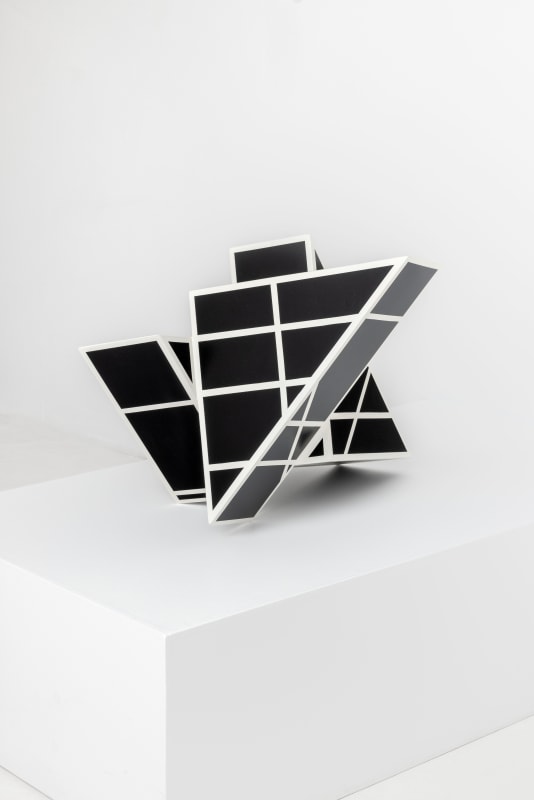The 100th Show
Espace Meyer Zafra is pleased to present “The 100th Show”, the 100th show at the gallery bringing together the works of Marina Apollonio, Ennio L. Chiggio, Alexis Hayère, Piotr Kowalski, Manuel Mérida, Rene Ugarte and Grazia Varisco.
In the 1960s, Marina Apollonio (1940 - ) began to design illusionist visual experiences. By choosing primary forms such as the circle, the artist studies his structural possibilities to be able to make the work active. Along with other members of the kinetic movement, Marina Apollonio shares the desire for depersonalized art, in opposition to the concept of expressive abstraction. It uses modern industrial materials to create structures calculated in such a way that they transform into space.
Ennio Ludovico Chiggio (1938 - 2020) carried out technical studies and, later, artistic studies in Venice, where he inconsistently attended the Academy and the Faculty of Architecture. In 1957, he began to paint. In 1959, in Padua, he founded the Enne Group along with Biasi, Costa, Landi and Massironi, where he worked in the field of kinetic images, studying light interference and motion changes. The activities carried out within the group became more intense, with a gradual awareness that these object-works were capable of modifying artistic learning and use according to the theories of form, information and quantum mechanics.
The transitions made between painting and sculpture by Alexis Hayère (1988 - ) demonstrate a creative logic which consists of composing elements together, of envisioning spaces where heterogeneous components coexist. Far from functioning as an external motif, the frame, unlike the base in sculpture, is part of the work, it composes with it, so that the latter is not a painting OR a sculpture, but a painting AND a sculpture. Here, the idea of composition must be understood in its strong sense; it designates a process of assembling distinct elements.
“Piotr Kowalski’s position is unique, combining Arts and Science, and keeping with the times alike those of Leonardo Da Vinci and Dürer in their eras. His art has often been compared to the movement of lumino-kinetics with which he shares certain conceptions: it is in reality closer to that of Takis or Jean Dupuy, technological and experimental, very defined and non-formal, located between materiality and the virtual and always looking for the novelty. » - Serge Lemoine. Piotr Kowalski (1927-2004) is a major and marginal figure in Art History. Kowalski uses technology like we use colors in painting. Throughout Kowalski’s work, the action of Science on artistic conception is constant, his work essentially focusing on the relationship between physical laws and matter, just like the poetry present there.
Manuel Merida (1939 - ) is one of the South American kinetic artists of the second generation. Through his work, the artist wants to avoid proposing a fixed and unique vision, playing with the variations of the colored matter (pigments, sand, coal powder, wood particles, painted metal, etc.) contained in his monochrome. Honored for its aestheticism and for its captivating effect on the viewer, and despite the marginalization of his work that we often like to associate with kinetics, the work of Manuel Mérida remains of no less importance in the history of art. The works are always mobile. Of various shapes, sizes and colors, they are composed of boxes of square or circular shapes, protected by a glass plate, rotating around a central axis. The others, activated by an engine, move slowly.
Sensitive and sober, the work of Rene Ugarte (1951 - ) is the fruit of a coherent reflection and a rigorous discipline. Based on the concept of structure, his paintings, executed on canvas and wood, reveal a simple configuration: the use of pure forms (square and rectangle) and the line in an alternative and repetitive way. Ugarte is developing a network of lines that cross the board horizontally, vertically and diagonally. The diagonal that he uses in a systematic way allows him to accentuate the dynamism of the work. Through this network of lines, orthogonal shapes determined by solid colors appear. Nevertheless, this rigorous geometrical structure which gives the painting an impression of balance and visual unity, is none the less illusory. It is the imbalance, the asymmetry, the destructuring that the artist seeks in his work. So he plays with ambiguity and dynamics to acquire a greater presence in space and come to a new reading, a discontinuous reading of his work.
Born in Milan, Grazia Varisco (1937 - ) has been a key representative of programmed and kinetic art throughout her artistic career. Varisco was one of the first artists who explored concepts such as motion and changes in time, while seeking a direct interaction with her audience. Through the use of simple geometric signs, her artworks inhabit the space around them, creating different spatial dimensions that challenge the viewer’s perception and disorientate the senses.







